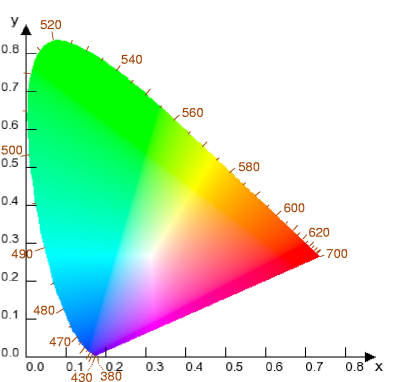 The CIE colour space (International Commission on Illumination - from the French "Commission Internationale de L'Eclairage") is a projection of the three-dimensional CIE XYZ colour space to a convenient two-dimesional xyY plane. It characterizes colours using a parameter Y for luminance, and two parameters x and y which define the location of a colour on the chromaticity diagram. The human eye is described as trichromatic because it has three different types of colur-sensitive cones, but the CIE colour space allows any perceived colour to be defined by two colour chromaticity co-ordinates, x and y. Colours which can be matched by combining three primary colours, typically red, green and blue, can then be defined on the chromaticity diagram by enclosing them in a triangle formed by joining the three sets of primary colour co-ordinates with straight lines.
The CIE colour space (International Commission on Illumination - from the French "Commission Internationale de L'Eclairage") is a projection of the three-dimensional CIE XYZ colour space to a convenient two-dimesional xyY plane. It characterizes colours using a parameter Y for luminance, and two parameters x and y which define the location of a colour on the chromaticity diagram. The human eye is described as trichromatic because it has three different types of colur-sensitive cones, but the CIE colour space allows any perceived colour to be defined by two colour chromaticity co-ordinates, x and y. Colours which can be matched by combining three primary colours, typically red, green and blue, can then be defined on the chromaticity diagram by enclosing them in a triangle formed by joining the three sets of primary colour co-ordinates with straight lines.
The CIE chromaticity diagram was first published back in 1931 but has since been revised on two occasions - in 1960 and in 1976. It is important to realize that all three versions contain the same information. The differences between them are just a matter of scale. The latest version has the advantage that physical distances between colours in the diagram are proportional to their perceived colour differences. Colours of the visible specrtum, ranging from violet to red, are positioned along the tongue-shaped curve known as the spectral energy locus, and the straight base line is known as the purple line. The so-called point of equal energy (the white point located at the lower centre of the diagram) identifies the location of the CIE-defined standard for white light.
Pure, fully saturated, colours lie on the spectral energy locus, and a straight line between two points within the area of the spectral energy locus defines all colours that may be produced by their additive combination. A triangle whose vertices fall within the spectral energy locus encloses the gamut of colours that may be obtained by combining additively the three colours located at the triangle's vertices. Note that no triangle formed by three points within the spectral energy locus can enclose all the colours of the diagram - ie all those that the human eye can perceive. The RGB system used by a computer monitor is therefore incapable of representing precisely all the colours the human eye is capable of seeing. The diagram on the left consequently has white added to eliminate negative RGB values.






